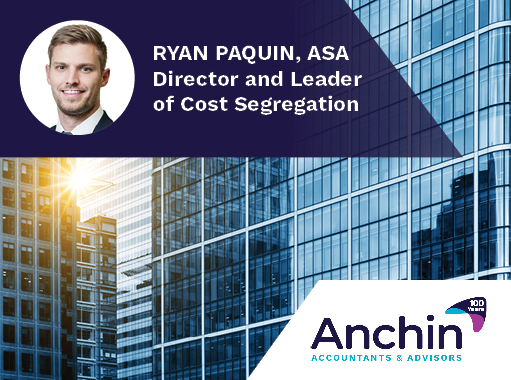How Step-Up in Basis Can Free up Cashflow for Property Heirs

Written by: Ryan Paquin, Director and Leader of Anchin’s Cost Segregation Group, ryan.paquin@anchin.com
For many individuals and family-owned businesses, residential rentals and commercial properties are more than investments—they are legacies that can be passed down through generations. These properties can provide significant wealth, but in order to take full advantage of them, it is crucial that heirs are aware of the tax implications and all of the potential savings available.
A “step-up in basis” can be of great value to a family-owned business as it is a tax provision, which re-evaluates the cost basis of an asset to the current fair market value at the time of an owner’s death. On its own, it offers powerful tax savings for heirs who sell. When combined with cost segregation and bonus depreciation strategies, however, a basis step-up is equally powerful in maximizing a property’s financial potential for heirs who retain the property.

What is a Step-up in Basis?
When a property owner dies, the IRS uses the fair market value (FMV) of their certain assets, including real estate, at the time of their death as the cost basis for their heirs’ taxes when they sell those assets. Accordingly, the first and most obvious advantage to heirs is that the step-up in basis minimizes the capital gains taxes owed if they sell the asset later. However, when combined with cost segregation and, in some cases bonus depreciation, a step-up in basis affords other advantages as well.
Before we get into the details, let’s do a quick recap of cost segregation and bonus depreciation:
Cost Segregation
Cost segregation is the practice of accelerating depreciation as it relates to real estate assets. Under current regulations, residential and commercial properties are assigned a depreciable life of 27.5 and 39 years respectively, meaning they will depreciate by the same amount each year for that amount of time.
With cost segregation, property owners can separate out (segregate) non-structural components of the property and depreciate them over 5, 7, or 15 years instead. This essentially “front loads” depreciation expenses, freeing up more money during the first few years of property ownership that can then be used for other investments. Typically, 15 – 35% of a property’s depreciable basis can be moved to a recovery life of 5,7 or 15 years.
Bonus Depreciation
It gets better: in some instances, bonus depreciation allows property owners to take the depreciation expenses for these segregated components in the first year they are placed in service. In a handful of years, bonus depreciation even extends to 100% of the property’s value, meaning for tax purposes the asset would be treated as if it is fully depreciated the year it’s capitalized. Bonus depreciation remained at 100% from September 2017 through December 2022, and has since started sunsetting by 20% per year, putting it at 80% in 2023. It’s important to note the applicable bonus percentage relates to the capitalized date of the step-up and not the date in which a cost segregation analysis occurs.
There are some limitations to the application of bonus depreciation, however. If a §754 election is in effect, a basis step-up under §743(b) will qualify for bonus depreciation only if the transaction is between unrelated partners. If a transfer is between related parties, the adjustment will not qualify for bonus depreciation.
What Does the Step-up in Basis Mean for Heirs?
Thanks to the step-up, a property’s depreciation period essentially “resets” upon the death of its owners, so older properties that have fully depreciated can now start over. Due to cost segregation, this applies to property components as well. If the property qualifies for bonus depreciation, the amount saved in taxes during the first year of new ownership can be substantial.
While the total depreciable amount will be the same over the course of the asset’s life no matter the span it is depreciated over, the ability to maximize depreciation early on should not be overlooked. The combination of a step-up in basis with cost segregation, and possibly bonus depreciation, frees up cash flow during the critical early stages of new ownership, giving heirs more options to make capital improvements on the property or otherwise invest the money saved where it can appreciate over time.
In addition to an analysis on the stepped-up basis, if the initial investment of the property still has depreciable basis and hasn’t undergone a cost segregation previously, there could be even more value in having an analysis performed. By applying for a change of accounting method, a taxpayer can take advantage of a cost segregation to retroactively “catch up” on the original asset’s depreciation in the current tax year.
Can a Cost Segregation Study Benefit You?
If you own or have recently inherited a residential rental or commercial property, Anchin’s cost segregation team may be able to uncover significant tax savings. In addition to accelerating the depreciation of recent acquisitions or construction projects, we also look at historical fixed asset records for potential repairs and maintenance expenses along with capital projects that could benefit from a retroactive analysis. Through means of a change of accounting method, companies can take advantage of a cost segregation analysis if there is still material depreciable basis left in a given asset.
It is important to make informed decision about whether a cost segregation study makes sense for your situation. Anchin will conduct a free upfront estimate of the potential net present value savings generated by a full analysis. To discuss how you could benefit from a cost segregation analysis on your properties, contact Ryan Paquin, Director and Leader of Anchin’s Cost Segregation Group at ryan.paquin@anchin.com.


